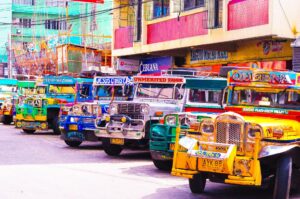
In a country where the government functions as a moneymaking enterprise and where bureaucrats dress their graft-ridden schemes with arrogance and the greenest of arguments, the architects of the Public Utility Vehicle Modernization Program (PUVMP) wanted all jeepneys phased out, to be replaced with electric vehicles (EVs) and light buses that run on less polluting fuels.
PUVMP was one of the first programs designed by the Department of Transportation (DOTR) under the Duterte administration to “declog” the National Capital Region (NCR), smoothen the horrendous traffic snarls and cut pollution due to vehicle exhausts. The former president hated the NCR gridlock, regarded as the worst in the world, that he wanted to be in Davao City most of the time.
By April 20, 2024, all public utility vehicles (PUVs) will have to be registered with transport coops or corporations for them to ply their routes and not be accosted by the Land Transportation Office (LTO.) To be enrolled in the program, jeepneys must not be 15-years-old and their fuel must hew to European standards, meaning no diesel, no lead gasoline. To sweeten the much-reviled PUVMP, the DOTR offered some subsidies to jeepney drivers and UV Express and TNVS operators.
Under the leadership of former Transport Secretary Arturo Tugade, the PUVMP was pushed to more than 140,000 jeepney drivers with established routes in NCR, with the deadline for compliance set late in 2023, only to be extended by President Ferdinand Marcos Jr. to April 30, 2024. PUVMP should be junked immediately by Malacanang since the very idea of kicking out jeepneys from the face of the entire Philippines is premised on the wrong assumption that they cause horrendous traffic, their engines blackening the already black sky of Metro Manila and their undisciplined drivers causing accidents left and right.
Moreover, Duterte’s minions naturally favored Chinese vehicle manufacturers whose so-called “modern jeepneys” cost between P2.5-million and P3-million each, amounts which jeepney-owning drivers could not afford. It is next to impossible to believe that the promoters of this scheme did not profit from the favored sellers of vehicles for PUVMP. Piston and other transport groups have staged protest motorcades and transport strikes to protest the implementation of the program while business owners, the Management Association of the Philippines (MAP) and even Sergio Ortiz-Luis, president of the Employers Confederation of the Philippines (ECOP) have urged Malacanang to postpone the implementation of PUVMP indefinitely. Business owners know that most employees ride jeepneys, UV Express and TNVS units. Kicking them out of the streets is tantamount to denying workers their right to patronize cheap modes of public transportation.
MAP and ECOP, along with millions of commuters in NCR, are appalled by the failure of the government to develop a comprehensive and well-designed rapid bus transit system in NCR while allowing expressways with higher toll for private cars to operate and digging deep in Quezon City for a subway that would ease the flow of vehicles to the Ninoy Aquino International Airport (NAIA.) They should be reminded about the Braess’s Paradox developed in Germany, which says that adding one or more roads to the existing road network will counter-intuitively increase traffic congestion and slow down the overall traffic flow.
If the government were really concerned about modernizing the iconic jeepney, it could have started the ball rolling by discussing the issue with drivers and operators as early as 2016 and tackling the matter of vehicle production with Sarao Motors and Francisco Motors Corp. (FMC), the traditional makers of jeepneys, which have exported the vehicles to Africa and elsewhere. However, some wise guys close to China thought of making hay by developing PUVMP as a cash cow for Chinese vehicle makers and a source of dirty money for bureaucrats.
Out of the 9 million land vehicles in the Philippines, only about 200,000 are jeepneys, a minuscule number but an important transport mode as more than 40% of motorized person trips are made through jeepneys. In NCR alone, 9 million people ride jeepneys daily. Nationwide, there are no less than 600,000 jeepney drivers. Based on these numbers alone, the jeepney segment of the transport sector is significant and the drivers that ply them earn their keep without significant help from the government. Jeepneys hardly ply the EDSA route, which is the daily traffic chokepoint in the NCR, where a total of 506,410 private cars are based. In 2023 alone, 441,100 new private cars were purchased, bulk of them in NCR. (DEO MAGNO)